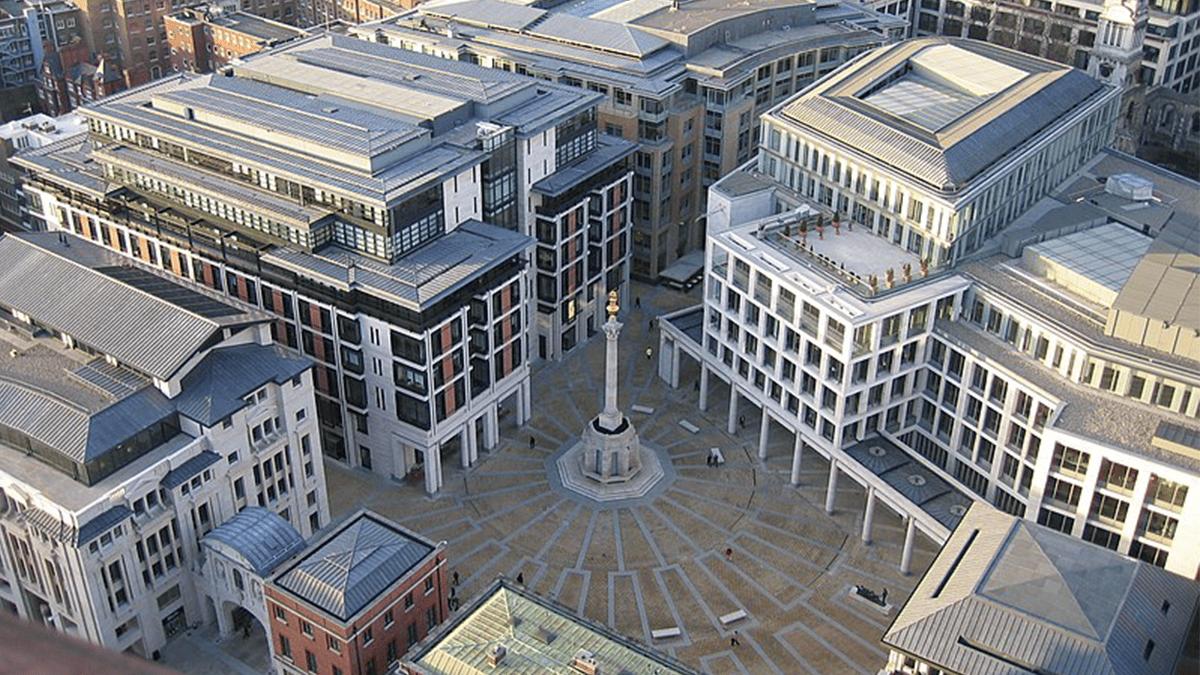We’re exploring the history and stories of Temple Bar, the ceremonial gateway between Westminster and the City of London, and how it moved from Fleet Street to Paternoster Square.
Embed from Getty ImagesFleet Street
The Royal Court of Justice on Fleet Street has been scene of many a famous court case, from celebrities to politicians.
Whilst Fleet Street looks pretty ordinary today, it would have looked VERY different a few hundred years ago.
Embed from Getty ImagesIt’s named after a river that flows nearby, not the Thames but the River Fleet, which today is one of the city’s hidden rivers, running from Hampstead Heath and joining the Thames underneath Blackfriars Bridge.
It was covered over after becoming an open sewer; people used to chuck all sorts in like food, human waste and even the remains of dead animals. Imagine the smell!
Fleet Street is one of the oldest roads outside the original city of London.
It runs east from Temple Bar, the boundary between the cities of London and Westminster, crossing Chancery Lane, Fetter Lane and Whitefriars Street to reach Ludgate Circus and has been a place for businesses since the Middle Ages.
Tanning of animal hides was a popular business, which would have added to the pong!
Embed from Getty ImagesTemple Bar Memorial
Temple Bar Memorial is in the middle of the road by the Law Courts.
It marks the place where Temple Bar Gate used to stand. The old gate was removed in 1878 because it was causing traffic jams on the busy road. It’s now restored and re-erected in Paternoster Square.
Embed from Getty ImagesThere are two grand bronze statues on either side of the memorial. One’s of Queen Victoria, the other Prince Edward, the Prince of Wales at the time.
They’re celebrated here because in 1872 they were the last royals to pass through the gate before it was demolished, on their way to attend a thanksgiving service at St Paul’s Cathedral for the Prince’s recovery from typhoid.
Embed from Getty ImagesWhenever the Monarch enters the city, they are met here by the Lord Mayor and Aldermen, and presented with the Lord Mayor’s Sword of State as a sign of loyalty – a tradition still carried out today. On the Strand side of the memorial, you can see a carving depicting the time when Queen Victoria was met by the Lord Mayor on her way to Guildhall a few months after her accession. On the other is a farewell to the Temple Bar in this location, with a curtain being drawn across.
On top of the memorial is a dragon – the symbol of the City of London, in the role as guardians of the City’s treasure. They feature on the City Arms along with the Cross of St George. You’ll find dragons in lots of places, marking the boundary of the City.
Fleet Street
Fleet Street is famous for being home to the newspaper industry.
Embed from Getty ImagesPublishing started here around 1500 when William Caxton’s apprentice, the brilliantly named Wynkyn de Worde, set up a printing shop near Shoe Lane.
The first daily newspapers were being published by the beginning of the 18th century, and for hundreds of years, the newspaper was the only way of finding out what was going on across the country and world.
Embed from Getty ImagesWhilst fewer printed newspapers are sold today, millions still consume newspapers each day – just online. What a variety of newspapers there were! Publications ranged from scandal sheets like John Bull to William Cobbett’s Political Register to The Times which is still in print today.
Newspaper companies were everywhere and drove out most of Fleet Street’s other businesses, especially after regional newspapers like the Yorkshire Post and Manchester Guardian opened London offices.

If you wanted to print a newspaper, Fleet Street was the place to be! Well, until the late 20th century when the number of titles halved and newspapers relocated their offices and printing works. By the 1980s there was no more late night clickety clacks from the printing works. Fleet Street fell silent.
- The Beano still has an office at 185 Fleet Street. The DC Thompson Building is now home to the Beano Studios. Look through window and you’ll see an old printing press and perhaps a famous character!
- The former Daily Express building at 120 Fleet Street – is a Grade 2 listed fine art deco building, clad in black glass, with a cinema-style foyer.
- The former Daily Telegraph building at Peterborough House, 135 Fleet Street – another very dramatic 1920s Art Deco building with attractive Egyptian decorations and an ornate overhanging clock
A famous character who lived nearby was Dr Samuel Johnson.
Embed from Getty ImagesHe lived in Gough Square where he compiled the first comprehensive English dictionary. His house has been restored to its original condition, with panelled rooms, a pine staircase and a collection of period furniture and portraits. You can get there through Johnson’s Court by 167 Fleet Street. Something to look out for is a statue of his cat, Hodge.

As well as newspapers, Fleet Street is also famous for being home to lawyers, with an entrance to the Honourable Society of the Middle Temple by 11 Fleet Street, and private banks, including C. Hoare & Co, England’s oldest privately owned bank, which has been operating at 37 Fleet Street since 1690.

- At 18 Fleet Street is a plaque to the Automobile Association which opened its first office here in 1905.
- Just before Shoe Lane at 81 Fleet Street is a plaque for The Fleet Conduit, which brought drinking water to the city.
- By 88 Fleet Street there’s the steeple of St Bride’s church in St Bride’s Avenue. St Bride’s steeple is said to have inspired the design for the modern wedding cake. It consists of four tiers, each diminishing in size as you go high – just like on a wedding cake!

Shoe Lane and St Bride Street
At the Junction of Shoe Lane and St Bride Street is a statue called ‘Resolution’, it’s a cast iron figure constructed from small cubes of metal.
This was Anthony Gormley’s first artwork in the City of London. The rusting steel blocks are piled up to look like a man. In fact, he looks a bit like a Minecraft character! All he needs is a pickaxe!

Shoe Lane was once known as Sholand, taking its name from the ancient ‘Sho Well’ which was located to the north.
Here’s some trivia! This area was famous for cockfighting.
Samuel Pepys and other men of society would regularly frequent the cockfights here. Lots of well-known people visited Shoe Lane.

William Shakespeare would come to visit an Italian scholar called John Florio. He was the go-to guy for anything Italian at the time. It’s thought Shakespeare consulted him regarding dialogue for Romeo & Juliet.
Embed from Getty ImagesFor such an unassuming looking street, it’s chock full of history.
Did you know that officially only 6 people died in the Great Fire and one of those lived here. Paul Lovell refused to leave his home as he feared it would be looted, and sadly died.
Ludgate Hill
Ludgate Hill is one of three hills in the City of London. The others are Tower Hill and Corn Hill.
Ludgate was also one of the original seven city gates and the others were Newgate, Aldersgate, Cripplegate, Moorgate, Bishopsgate and Aldgate.
The gate here at Ludgate was demolished in 1760. You can blue plaque where the gate would have been on the wall at the Church of St Martin Within Ludgate.

The area’s changed a lot over the centuries, there used to be many small alleys around here but they were swept away in the 1860s when the London, Chatham and Dover Railway built Ludgate Hill railway station. It closed in 1929 and a railway bridge that used to cross the road, blocking the view of the Cathedral, was demolished in 1990.

There are references to Ludgate going back a very long time. If you’re wondering where the name comes from there’s a few theories about that!
- Ludgate is mentioned in Geoffrey of Monmouth’s Historia Regum Britanniae which he wrote around 1136. Even earlier, the Cronycullys of Englonde tell us of an early king of Britain that “lete make a fayre gate and called hit Lud Gate after his name” in the year 66 BC. Another theory is that it comes from the Old English term “hlid-geat” – a common Old English compound meaning “postern” or “swing gate”.
- We’ve mentioned William Shakespeare and his plays. Well, in Limeburner Lane, there used to be a place where plays were performed even before Shakespeare’s time. It’s mentioned in Thomas Hughes’ Tom Brown’s Schooldays and Charles Dickens’ The Pickwick Papers.
- Later in the 1700s, Ludgate embraced the craze for coffee and coffee houses. The famous London Coffee House at 24 Ludgate Hill was frequented by Joseph Priestley and Benjamin Franklin. When the juries at the Old Bailey failed to reach a verdict, they were housed here overnight.
Paternoster Square
Embed from Getty ImagesIn Paternoster Square we’ve come full circle because here you can see Sir Christopher Wren’s Temple Bar – the historic gate which was originally where the Temple Bar Memorial is.
Temple Bar is the only surviving gateway to the City of London. It’s called Temple due to its original vicinity to the Temple, an area where the guilds of lawyers organised into what would become the Inns of Court. Originally not much more than a chain between wooden posts, it was rebuilt in timber around 1400, with a prison above.

Whilst the gate survived the Great Fire, it had fallen into disrepair and under the orders of Charles II, was rebuilt with Portland stone from the Royal quarries in Dorset, demonstrating the importance that the King placed on the project and that Temple Bar was as much a royal monument as a city one.
A bit of gruesome history, during the 18th century, Temple Bar was used to display the heads of traitors on iron spikes which protruded from the top of the main arch. The last heads to be displayed were those of Towneley and Fletcher, who were taken at the Siege of Carlisle and executed in 1746.

So how did the gate end up here?
Firstly, and most importantly, Fleet Street needed widening to help with the heavy traffic! In fact, Charles Dickens described it as ‘a leadenheaded old obstruction’ in Bleak House.
There was strong attachment to the Bar and rather than see it cleared away, it was taken down brick by brick, beam by beam, numbered stone by stone, and stored until a decision for its re-erection could be reached. It was rebuilt here in 2004 as a gateway to the central piazza at the Paternoster Square next to St Paul’s Cathedral and is now home to the Worshipful Company of Chartered Architects!
Embed from Getty ImagesPaternoster Square has an interesting past. It can trace its origin to the medieval Paternoster Row. Paternoster means Lords Prayer and the Row was a place where the clergy walked holding their rosary beads and reciting the prayer. Over time, it became a hub for peddlers of spiritual goods like rosaries and prayer books, as well as visitors and pilgrims of St Pauls.
It would continue to be busy with shops of all sorts until the great fire of London. After that, it became popular with stationery shops and publishers and of course, coffee shops.
In the Second World War, the area was badly damaged. On one night alone, several million books were lost when the booksellers’ shops were destroyed by fire.
Other places nearby to explore…
- THE OLD BAILEY – A famous court where criminals from all over the country are tried for their crimes, but for many hundreds of years the site of Newgate Prison. Built in 1188 as a place to hold prisoners before their trial. It was famously a horrible place, overcrowded and rife with disease. They say it was so dirty that the floors would crunch as you walked because of all the lice and bedbugs you were stepping on. There’s still some of the old prison that you can see… in Amen Court, you can see one of the surviving walls of the prison.
- CHRISTCHURCH GREYFRIARS CHURCH – In the Middle Ages, site of a Franciscan monastery. There used to be a library here, built by a certain Richard Whittington. That name might ring a bell… Dick Whittington, Lord Mayor of London!
London’s History
London has a rich and full history that we can't wait to tell you all about! From The Romans of Londinium to the Tudors of London, it's all here.
More From London’s History







